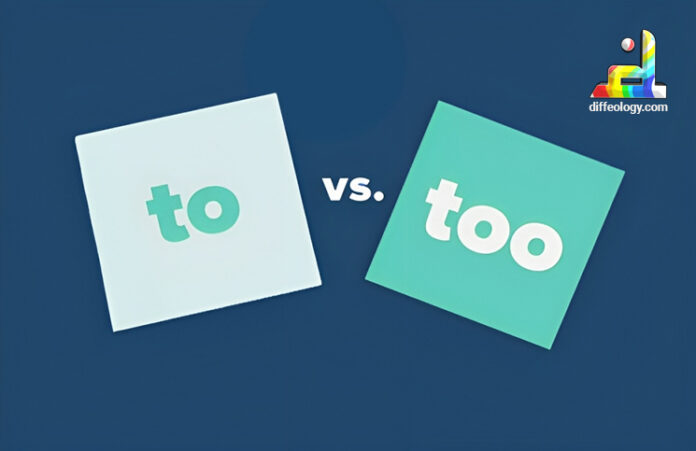“To” and “too” may seem similar, but they serve different purposes in English. You have to understand the difference between to and too for using them perfectly. “To” is used to show direction, purpose, or action. For example, “I went to the store” or “She wants to learn.” On the other hand, “too” means “also” or “excessively.” It’s used when you want to say that something is in addition to something else or when something is more than necessary. For instance, “I want to go too” or “That cake is too sweet.”
Main Difference Between To and Too
The main difference between to and too is how they’re used in sentences. “To” is commonly used to indicate direction, purpose, or action. For example, in the sentence “I am going to the park,” “to” shows the direction of movement towards the park. Similarly, in “She wants to learn,” “to” is used to express the purpose of wanting – in this case, to learn something.
On the other hand, “too” is used to express excess or addition. It’s like saying “also” or “more than enough.” For instance, in the sentence “She ate too much cake,” “too” indicates that she ate more cake than she should or more than is necessary. Likewise, in “I want to go too,” “too” means that the speaker wants to join or participate in addition to someone else who is going. Understanding this difference helps in using the right word in different contexts, making sentences clearer and more accurate.
To Vs. Too
What Is “To”
“To” is a small but powerful word that helps us understand direction and purpose. Imagine you want to go to the park. In this sentence, “to” tells us where you want to go. It shows the direction of your movement. Another example is when you say, “I want to eat.” Here, “to” tells us your purpose, which is to eat. It helps connect what you want with what you’re going to do.
Read Also: Difference Between Then and Than
In simpler terms, “to” is like a signpost that points us in the right direction or tells us what someone wants to do. It’s very common in everyday language. Whether you’re talking about going somewhere, doing something, or giving something, “to” helps clarify the meaning. So, whenever you see “to” in a sentence, think about where someone is going or what someone wants to achieve.
What Is “Too”
“Too” is a tiny but important word that tells us when something is more than what’s needed or expected. Imagine you have a big bowl of ice cream, but you can’t finish it because it’s too much. Here, “too” shows that there’s more ice cream than you can eat. Another example is when you say, “It’s too cold outside.” In this case, “too” tells us that the weather is colder than what’s comfortable.
Read Also: Difference Between A and An
In simpler terms, “too” is like a signal that something is excessive or beyond the usual amount. It’s often used to express that something is not just enough but maybe even a bit too much. Whether it’s about temperature, quantity, or intensity, “too” helps convey that something is more than necessary. So, whenever you hear or see “too” in a sentence, remember that it’s highlighting an excess of something.
Comparison Table “To Vs. Too”
| Spelling | One “o” | Two “o”s |
| Function | Direction or purpose | Signifies excess or addition |
| Context | Connects parts of a sentence | Modifies adjectives or adverbs |
| Quantity | Doesn’t indicate quantity | Implies excess or more than needed |
| Sentence Structure | Part of the sentence structure | Typically placed at the end of a sentence |
| Emphasis | Emphasizes direction or purpose | Emphasizes excess or extremity |
| Examples | I want to swim. | It’s too hot outside. |
| Placement | Can appear anywhere in a sentence | Usually appears at the end of a sentence |
| Use with Verbs | Connects verbs with their objects | Doesn’t work with verbs |
| Use with Adjectives | Doesn’t modify adjectives | Modifies adjectives |
| Common Usage | More commonly used | Used less frequently |
| Direction vs. Excess | Indicates direction | Signifies excess |
| Purpose vs. Intensity | Indicates purpose | Indicates intensity |
| Adverb vs. Preposition | Preposition | Functions as an adverb |
Difference Between To And Too In Detail
1. Spelling:
“To” and “too” may sound similar, but they are spelled differently and have distinct meanings. “To” is used as a preposition, indicating direction or movement towards a place, person, or thing. For example, “I am going to the park.” On the other hand, “too” is used to indicate excess or addition. For instance, “He ate too many cookies.”
2. Function:
The primary function of “to” is to express a variety of relationships such as direction, destination, or purpose. It’s used in contexts like “She went to school” or “I want to play soccer.” On the contrary, “too” is primarily used to indicate an excessive degree or an addition to something. For example, “It’s too hot outside” or “I ate too much pizza.”
3. Context:
“To” is often used to link verbs with their objects or to connect different parts of a sentence. For instance, “She gave the book to her friend” or “He likes to swim.” Conversely, “too” usually appears at the end of a sentence and modifies an adjective or an adverb, indicating an extreme or additional quantity. For example, “The movie was too long” or “He is driving too fast.”
4. Quantity:
“To” generally doesn’t indicate quantity but rather direction or purpose. It’s used to specify where someone or something is going or what someone intends to do. For example, “She went to the store” or “He wants to learn guitar.” On the other hand, “too” often implies excess or more than necessary. For example, “The backpack is too heavy” or “She talked too much.”
5. Sentence Structure:
“To” is commonly found within the sentence structure, connecting different elements such as subjects and verbs or verbs and objects. For example, “She decided to study” or “He loves to read books.” However, “too” is usually placed at the end of a sentence and modifies an adjective or an adverb to indicate excess or addition. For instance, “The dog is too loud” or “She walks too slowly.”
6. Emphasis:
“To” typically emphasizes the direction, purpose, or intention of an action. It clarifies where someone or something is headed or what someone wants to achieve. For example, “They are going to the beach” or “She needs to finish her homework.” On the contrary, “too” emphasizes an excessive or unnecessary amount of something. For example, “It’s too late to go outside” or “He’s talking too loudly.”
7. Examples:
“To” is frequently used in various everyday activities and statements, indicating movement, direction, or intention. For example, “He wants to play soccer” or “She needs to go to bed.” Conversely, “too” is used when something is excessive or more than necessary, adding emphasis on the extremity of a situation. For example, “The ice cream is too cold” or “It’s too dark to see.”
Key Points Difference Between To And Too
- Spelling: “To” has one “o”, while “too” has two.
- Function: “To” is used for direction or purpose. “Too” signifies excess or addition.
- Context: “To” connects parts of a sentence. “Too” modifies adjectives or adverbs.
- Quantity: “To” doesn’t indicate quantity. “Too” implies excess or more than needed.
- Sentence Structure: “To” is part of the sentence structure. “Too” is typically placed at the end of a sentence.
- Emphasis: “To” emphasizes direction or purpose. “Too” emphasizes excess or extremity.
- Examples: “To” in sentences like “I want to swim.” “Too” in sentences like “It’s too hot outside.”
- Placement: “To” can appear anywhere in a sentence. “Too” usually appears at the end of a sentence.
- Use with Verbs: “To” connects verbs with their objects. “Too” doesn’t work with verbs.
- Use with Adjectives: “To” doesn’t modify adjectives. “Too” modifies adjectives.
- Common Usage: “To” is more commonly used. “Too” is used less frequently.
- Direction vs. Excess: “To” indicates direction. “Too” signifies excess.
- Purpose vs. Intensity: “To” indicates purpose. “Too” indicates intensity.
- Adverb vs. Preposition: “To” is a preposition. “Too” functions as an adverb.
FAQs: To Vs. Too
Conclusion:
In summary, “to” and “too” are small but important words in English. “To” is used for actions, directions, and purposes, while “too” means “also” or “excessively.” Understanding the difference between to and too can help you communicate clearly and effectively in both speaking and writing. So next time you’re unsure, remember: “to” for actions, “too” for excess or addition.
References & External Links
- Examples of too in a sentence
- Examples of to in a sentence



